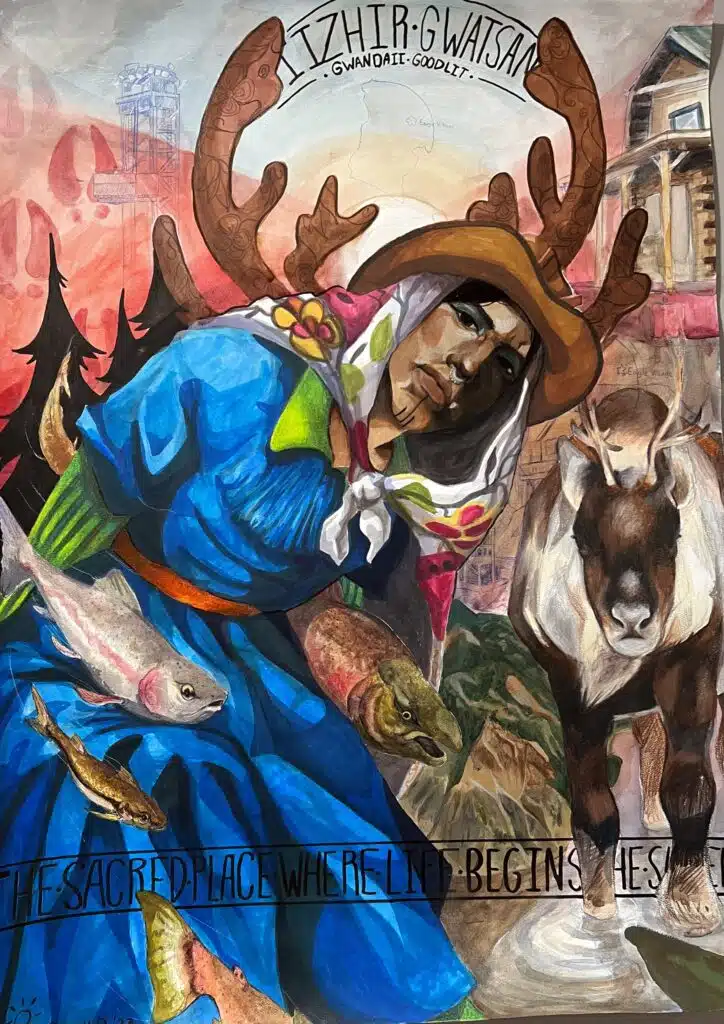
Land, Life, and Liberty
Highland Park, IL
2023, Senior, Art
Climate Hero: Quannah Chasinghorse
Reflection
I began this project knowing my goal was to make something that encapsulated not only my hero's good work but their essence as well - to illuminate and celebrate them as a figure, while simultaneously embracing the beautiful, complex, and important piece of nature they swore to protect. My project surrounds the activism of indigenous model and land protector, Quannah Chasinghorse. A member of the Hän Gwich'in people of North America, her hometown of Eagle Village rests on the banks of the Yukon river, a major watercourse that cuts through Canada and parts of Alaska. The Yukon territory in which it flows is home to the Arctic National Wildlife Refuge, a part of the ancestral territory of the Gwich'in people that continues to be integral to their survival today. The river supports a large breath of wildlife and is the place where porcupine caribou, the lifeblood of Gwich'in culture, go to calf. I chose to include the Gwitch'in name associated with the territory in my piece, "Iizhik Gwats'an Gwandaii Goodlit" or "the sacred place where life begins" to emphasize its cultural relevance. The relationship between people and caribou is strongly interlinked and goes beyond the necessity for food. I hoped to embody this connection in my art, mimicking the complex interconnections of the habitat as well as the inseparable association between man and nature. I composed my piece in the style of a collage, each image coming together to form one, folding over and intersecting one another, together directing your eyes in a circular motion to mimic the cyclical nature of life and being. My subjects were ones directly connected to the religion, invoking images of local wildlife like the porcupine caribou, the homes of Eagle village residents, the Yukon river, and of course Quannah herself. My choice of medium was not spared consideration - the mixing of materials like pen, acrylic, watercolor, gouache, colored pencil, and marker is meant to demonstrate the interwoven relationship at the center of Quannah's activism. Her role as a land protector is evident in her most famous piece of activism in 2019 where she, and many others, petitioned to stop the passing of bill HR1146, which would allow oil drilling in the Arctic National Wildlife Refuge. Oil drilling in this region would threaten one of the most important habitats of porcupine caribou and could lead to a decline in population and subsequent end to the Gwich'in way of life. Climate change, and in particular the laying of pipelines and oil drills, is a common plight of indigenous communities across the Americas. Groups like the Gwich'in who depend heavily on natural resources and who's culture is intertwined with their environment are particularly vulnerable. It's for this reason, among many others, that the voices of indigenous people around the globe serve an integral part to advancing us towards sustainable living. It's for all these reasons that I chose Quannah as my hero. Although I cannot communicate directly the sentiment stated above purely by visual means, my goal for this work was to represent what it is that Quannah is protecting - a way of life. Eco-activism is more than preserving nature, it is preserving people, culture, the right to live. One of the pitfalls of eco-activism is that most campaigns fail to place people at the center of the fight. Without drawing a direct connection between the human toll and the consequences of pollution, corporate exploitation, and climate change, it's difficult for the average person to understand what it is they're fighting for. I decided to make this piece to fill a niche, one where human lives are at the center of the discussion, where we are encouraged to sympathize rather than pity, and where a call to action means more than just adjusting personal habits.
